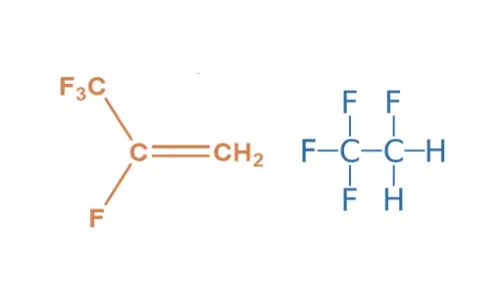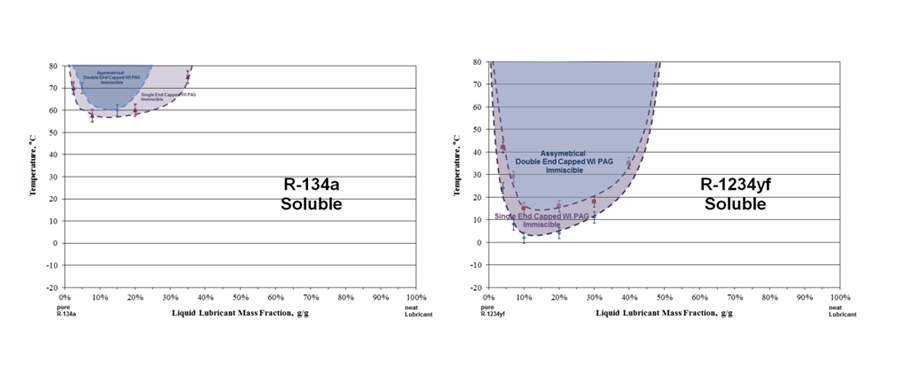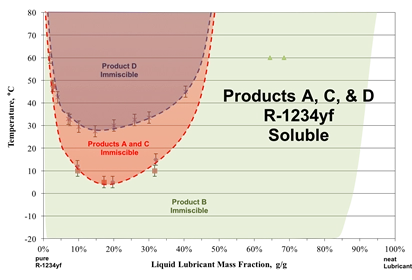R1234YF Lubricants
Technical Considerations When Selecting R-1234YF Service Lubricants
The current European aftermarket is being serviced by a limited range of commercially available lubricants which are promoted as being suitable for R1234yf refrigerant-based systems. Are these lubricants able to meet the chemical compatibility and miscibility requirements for long-term system operation when used in R1234yf systems?
When undertaking lubricant selection for HFO 1234yf oil compatibility systems there remains a market acceptance that specialty synthetic ‘double end-capped’ polyalkylene glycols (‘PAGs’) are the preferred OEM choice. However, there are specific technical factors that need to be considered and which have shown that double and single end-capped PAGs used in R134a systems to date need special consideration before using with R1234yf.
From a mechanical or thermal point of view, only modest design changes are required for HFO based MAC systems compared to R134a and in principle the performance requirements of the lubricant for R1234yf systems are very similar to R134a. However, what must be taken into account is the chemical structural difference of R1234yf refrigerant oil compared to R134a oil, which significantly influences the miscibility with the lubricant base fluid.
In particular, the double bond in the R1234yf molecular structure also results in a high level of chemical reactivity within the refrigerant system:

This is advantageous with respect to the environmental properties of the refrigerant, but disadvantageous with respect to chemical stability within the closed refrigeration system. Specifically, the lubricant has to be designed to help counteract the instability and maximize refrigerant miscibility, and industry needs to ensure correct lubricant selection for R1234yf systems now entering into the aftermarket.
This article evaluates four commercially available ISO Viscosity Grade 46 PAG lubricants from the European market, promoted specifically as being suitable for use with R1234yf.
LUBRICANT FUNCTION IN AUTOMOTIVE A/C SYSTEMS
The principal function of the lubricant in an automotive a/c system is to adequately lubricate all moving parts in the refrigerant compressor and auxiliary valves. Additionally, the lubricant aids in heat dissipation, sealing of compression chambers/valves and noise control.
The compressor type, system design, operating parameters, and the refrigerant and oil selection are factors which influence the varying amount of oil which may be present in the circuit. To ensure reliable oil circulation and ensure that the oil returns from the “cold” parts of the circuit, refrigeration oils with satisfactory miscibility in the corresponding refrigerant are needed.
The compressor requires a certain optimum oil viscosity according to compressor design and operating parameters. The optimum operating viscosity of the lubricant is subject to the influence of the refrigerant (temperature and pressure related dissolution of refrigerant). A compromise may be found between the minimum viscosity needed for reliable compressor lubrication and the necessary low-temperature flow properties needed to ensure sufficient oil return in the system.
Additionally, good thermal, chemical and hydrolytic stability in the presence of refrigerant, system metallic and elastomeric components and contaminants such as moisture, are important lubricant parameters. Increasing emphasis on electrically driven compressors also requires the lubricant to have suitable electrical insulation properties when used in these systems.
LUBRICANT TECHNICAL REQUIREMENTS FOR AFTERMARKET HFO LUBRICANTS

In addition to the above technical attributes, when selecting lubricants for refill/servicing applications, consideration should be given to compatibility with the original OEM specified lubricant (and other aftermarket oils which may have been used in the system), and the performance of the subsequent lubricant mixture.
Historically the dominant lubricant technology validated by compressor/vehicle OEMs for use with R134a systems has been double end-capped PAGs, which provide optimum performance.
The aftermarket industry has historically predominantly adopted “single end-capped” PAGs as a suitable service option, which also show adequate performance levels.
Polyol Esters (POE) type lubricants are occasionally used, despite their disadvantageous chemical reactivity with ingressed moisture to produce acidic bi-products.
MARKET TESTING
Four commercially available ISO Viscosity Grade 46 PAG lubricants from the European market, promoted as being suitable for use with R1234yf, have been selected for assessment of suitability for use with R1234yf. Basefluid and additive analysis determines the following compositional information:
| SAMPLE | COMPOSITIONAL ANALYSIS | SAMPLE | COMPOSITIONAL ANALYSIS |
|---|---|---|---|
| Product A | Basefluid: 100% standard single end-capped PAG - no additive present | Product B | Basefluid: A blend of 3 components: 25% A polyol typer ester; 50% A phthalate ester; 25% A standard single end-capped PAG - No additives present |
| Product C | Basefluid: Double end-capped PAG (77.9wt%) - 22.1% additives present, including antioxidant, antiwear and acid scavenger | Product D | Basefluid: Double end-capped PAG (97%) - 3% additives present, including antioxidant, antiwear, acid scavenger and metal passivators |
Miscibility impact
Miscibility of refrigerant/lubricant mixtures is assessed utilising method ASHRAE 86. It is shown that the miscibility of PAG lubricants utilised with R134a are adversely impacted when R1234yf is utilised;

Structural modification of the PAG basefluid is required in order to increase the Upper Critical Solution temperature (CST) to maximise the temperature range over which miscibility is observed and hence oil return within the system.
Below is shown a chart demonstrating the CSTs observed for PAG lubricants promoted for use with R1234yf. Product D demonstrated the highest CST.

Stability Impact
R1234yf contains a double bond C=C, which results in a high level of chemical reactivity. This is advantageous with respect to the environmental properties of the refrigerant, but is disadvantageous with respect to chemical stability within the closed refrigeration system.
Chemical, thermal and hydrolytic stability of refrigerant/lubricant mixtures is assessed utilising method ASHRAE 97, under standard conditions of 50/50 wt/wt R1234yf/lubricant with Cu, Al and Fe coupons, 1000ppm water, 175°C, 14 days. After aging the tube contents are examined for change in lubricant and metals, condition, TAN (total acid value) and by Ion Chromatography (IC) to determine refrigerant/lubricant decomposition.
SGT (Sealed Glass Tube) testing of commercially available R134a PAG lubricants in combination with R1234yf:


| 'R134A TYPE' SINGLE END-CAPPED PAG | 'R134A TYPE' DOUBLE END-CAPPED PAG | |
|---|---|---|
| Appearance | Lubricant slightly darkened (Colour 2.5 Gardner vs 2.0 for unaged sample) | Lubricant slightly darkened (Colour 3.0 Garnder vs 2.0 for unaged sample) |
| Coupons | Unchanged | Unchanged |
| TAN mgKOH/g [before/after] | 0.03/0.19 | 0.06/0.18 |
| Fluoride (ppm) [before/after] | 0/110 | 0/103 |
| Butyrate (ppm) [before/after] | 0/774 | 0/33 |
| Sulphate | 0/0 | 0/0 |
The post-test TAN values and appearance of coupons / lubricant initially suggest good system stability, however the use of IC to determine Fluoride / Butyrate content provide evidence that refrigerant and lubricant breakdown has occurred.
Modification of the lubricant additives are required to stabilise the refrigerant. The specific combination and dosage of additive components is critical to ensure the instability of R1234yf is minimised, but also in ensuring that the additives do not themselves contribute to incompatibilities within the system, eg. with elastomers.
Demonstration is made of the stability of the 4 commercial lubricants marketed as suitable for R1234yf:


| PRODUCT A | PRODUCT B | PRODUCT C | PRODUCT D | |
|---|---|---|---|---|
| Lubricant Appearance | Unchanged | Two phases & cloudy | Unchanged | Slight yellowing of lubricant |
| Coupon Appearance | Unchanged | Copper completely black | Unchanged | Unchanged |
| TAN mg KOH/g [before/after] | 0.01/0.35 | 0.31/0.90 | 0.03/0.38 | 0.05/0.13 |
| Fluoride (ppm) [before/after] | 0/196 | 0/1 | 0/71 | 0/44 |
| Butyrate (ppm) [before/after] | 0/300 | 0/17 | 0/149 | 0/119 |
| Conclusions | Significant refrigerant & lubricant breakdown | Inappropriate additive pack for R1234yf; Attacks Cu & brass | Acceptable Performance | Good performance |
TESTING CONCLUSIONS
Miscibility was varied for the 4 commercially available lubricants tested, only 1 of the 4 lubricants showed acceptable miscibility with R1234yf (Product D). Products A, B & C show an inferior miscibility profile with R1234yf compared to that which is routinely seen with PAGs used today with R134a. Both Product C and D are OEM validated lubricants for R1224yf, D is also qualified by an Automotive OEM as an “Universal Aftermarket Lubricant” for R1234yf.
In Summary, only 2 of the current 4 commercially available lubricants offer acceptable stability. This suggests that the products which offer unacceptable stability have not been properly evaluated for use with R1234yf and therefore not fit for purpose. OEMs have robust qualification programs; however, an overall industry standard does not exist for post-SGT test levels of fluoride (an indicator of HFO breakdown) and organic species such as Butyrate (an indicator of lubricant breakdown). Historically, method of stability testing of R134a lubricants is insufficiently detailed to provide sufficient instability data when testing lubricants for use in R1234yf systems.
A “UNIVERSAL” MAC LUBRICANT
In addition to the lubricant being designed to help counteract the R1234yf instability and maximize refrigerant miscibility, if a user wishes to use a PAG lubricant with an electric compressor, the electrical and compatibility properties of the lubricant with the motor components becomes vitally important.
Historically, POE lubricant types are the primary choice for stationary and mobile HVAC&R systems where motor windings are in direct contact with the lubricant, and this may be attributed to the higher electrical insulation properties (Volume Resistivity typically 1011Ωcm at 20ºC) compared to industrial PAG lubricants (Volume Resistivity typically ~108Ωcm at 20ºC).
However, optimisation of the PAG now enables electrical properties to be achieved which fully enable application of PAG lubricants in electrically driven Mobile Air Conditioning (MAC) systems.
Therefore, only the “Universal” product presents the market with an opportunity to utilise a single PAG lubricant for both R134a and R1234yf refrigerants. Product D has the appropriate miscibility/chemical stability properties developed for the more reactive environment within R1234yf systems and offers excellent backwardly compatible lubrication within R134a systems. The product can also bridge belt and electrically driven systems, making it a premium performance, “Universal Automotive HVAC Lubricant”.
To find out more about our Premium Universal Automotive HVAC Lubricant, please visit the link below:
Written for Automotive Airconditioning Reporter, AAR 107 – July-Aug 2017 by:
- Liz Dixon (PhD), Global Technology Director, Shrieve Products International Ltd.
- Christopher Seeton (PhD), Global Application Engineering Director, Shrieve Chemical Products Inc.
